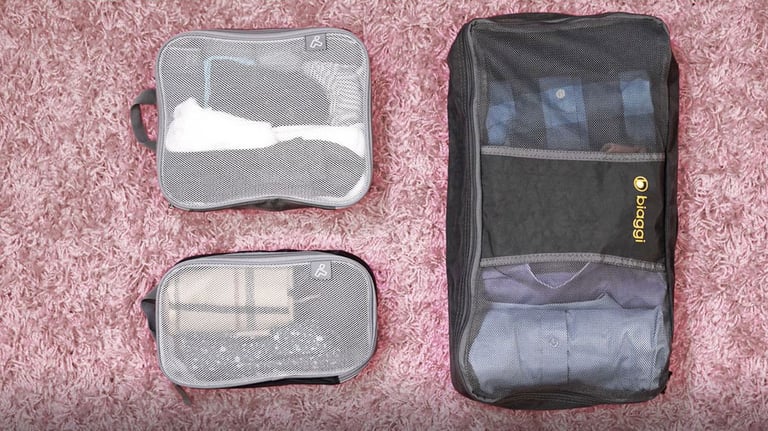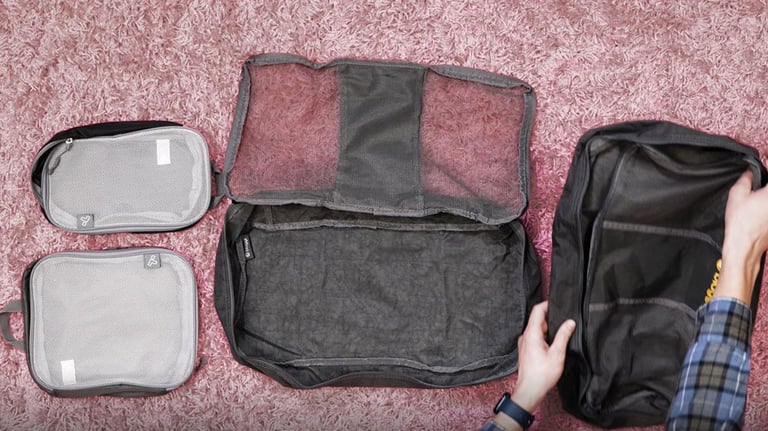
It's a common question for travelers—what is the most efficient way to pack a carry-on? With various methods ranging from rolling and stacking to simply praying everything fits without any organization whatsoever, new travel products have entered the market to aid with packing organization and saving space. With packing cubes being the latest trend in packing, we decided to put them to the test to see if traditional packing, standard packing cubes, or compression packing cubes provide for the most efficient packing method.
How we tested
We started by rounding up standard items someone would take on a business trip in a standard 21-inch carry-on bag:
- Suit (jacket and pants)
- Blazer
- 3 dress shirts
- Polo shirt
- T-shirt
- 2 pairs of chino pants
- 4 pairs of underwear
- 1 pair of dress socks
- 2 pairs of gym socks
- Belt
- Tie
- Boots
- Sneakers
- Scarf
- Tech organizer
- Toiletry Bag
Using the same standard 21-inch carry-on luggage with spinner wheels by Ricardo Beverly Hills, we planned to test three ways of packing:
- Rolling clothes and taking advantage of every square inch of the suitcase, including internal compartments.
- Utilizing standard packing cubes, packing by clothing type.
- Using compression packing cubes, packing by clothing type.
Throughout the test, we wanted to ensure that every item made it into the carry-on. Here are the results.
Rolling clothes method
Through careful technique, all items were able to fit into the carry-on. We rolled socks and placed them inside shoes to conserve space and placed the tech organizer, toiletry bag, and belt in the bag's internal storage compartment. We put the shoes toward the bottom end of the bag at the wheels and rolled all clothing on top, placing the suit jacket and blazer across the top. Everything fit in the bag with little room to spare. While space was at a premium, we noticed that clothes stayed relatively wrinkle-free.

Standard packing cubes method
Standard packing cubes, by brands like Travelon or Biaggi, allow those who crave organization latitude when packing. The usual fabric and mesh or plastic and mesh bags that come in various sizes will enable you to pack by outfit, clothing type, or whatever method works best for your needs.
In our test, we packed by clothing type—placing items like dress shirts in a packing cube, socks, belt, tie, and underwear in another, and so on. Using multiple sizes of packing cubes, we organized the suitcase's contents nicely, rolling clothing to conserve space. We kept the tech organizer and toiletry bag in the internal compartment rather than giving them their own packing cube. Starting with the shoes at the bottom of the bag, we layered the packing cubes in the remaining space. While the contents of the bags were organized, the suitcase barely closed over the packing cubes. Based on our test, this method took more space than our first test, the rolling method.

Compression packing cubes method
Like standard packing cubes, compression packing cubes allow for organization but with an extra perk: compressing items in the cube to save space through a double-zip feature. While the top zip provides access to the cube's contents, zipping the second zipper around the entire perimeter of the bag compresses the cube's contents, allowing air to escape out of the mesh top. It's similar to a vacuum compression bag but without a lot of hassle.
In this packing test, we once again tried to group items by clothing type using different-sized packing cubes. Pants and shirts were rolled and placed in a cube, accessories, socks, and underwear in another cube, and so on. Once again, shoes were placed at the bottom of the bag, and packing cubes were layered on top. The tech organizer and toiletry bag remained in the internal compartment. Plenty of space remained in the bag using this method, and it was effortless to close. Additional items could have been placed in the bag (or another cube) with ease. However, some things (like dress shirts) were wrinkled when unpacked from the packing cube.

The bottom line
Compression packing cubes conserved the most space in this test, followed by traditional rolled packing. While the standard packing cubes weren’t efficient when it came to saving space, they did allow for excellent organization. And while the compression packing cubes allowed for the most efficient and organized packing, clothing was easily wrinkled.
Regardless of which method you prefer to use to pack, packing cubes are worth exploring. And at a minimum, any of these methods are better than throwing everything in your carry-on in a rush and hoping for the best.

